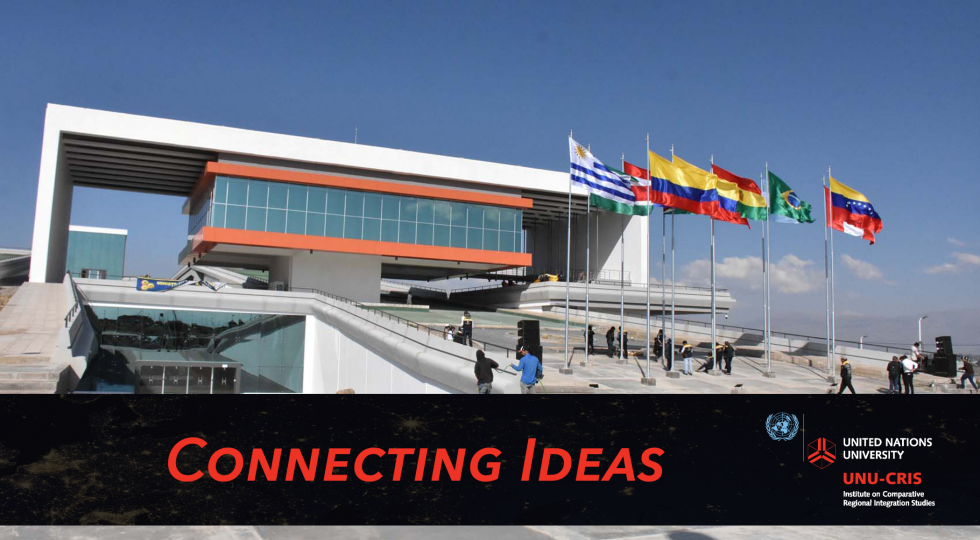Regionalism Under Stress: Europe and Latin America in Comparative Perspective


Detlef Nolte
Associate Fellow, GIGA German Institute of Global and Area Studies
Former director (2006–2018), GIGA Institute of Latin American Studies

Brigitte Weiffen
Visiting Professor, University of São Paulo

This post draws on the recently published volume “Regionalism Under Stress. Europe and Latin America in Comparative Perspective”, edited by Detlef Nolte and Brigitte Weiffen (https://www.routledge.com/Regionalism-Under-Stress-Europe-and-Latin-America-in-Comparative-Perspective/Nolte-Weiffen/p/book/9781138337725).
31 August 2020 | #20.29 | The views expressed in this post are those of the author and may not reflect those of UNU-CRIS.
In Europe and Latin America, regionalism is under stress. While still coping with the Eurozone crisis and its aftermath, the European Union (EU) has been facing multiple challenges, including conflicts in its neighbourhood, a massive influx of refugees, increasingly frequent terrorist attacks, regionalist and secessionist movements, the electoral success of Eurosceptic and anti-EU parties throughout the continent, and government participation or control by nationalist-populist forces in several Central and East European countries. Since 2016, negotiations over the British exit from the EU (Brexit) have been consuming immense amounts of political energy. Current attempts to manage the COVID-19 pandemic have temporarily stalled the resolution of other issues and have revitalized confrontations between debtor countries in the south and creditor countries in the north.
In Latin America, regional cooperation has been stagnating or is in decline. Economic problems in major countries, a lack of regional leadership, ideological conflicts fuelled by the “pink tide” in the 2000s and the resurgence of the right in recent years, as well as regional actors’ limitations in responding to social and political crises in general (and to the humanitarian crisis in Venezuela in particular) led to a standoff in the main regional organizations, as exemplified most drastically by the demise of the Union of South American Nations (UNASUR). The COVID-19 pandemic is further accelerating the pre-existing crisis of regional organizations.

The multifaceted nature of the current EU crisis can serve as the starting point for developing a taxonomy of stress factors for regionalism. While the specific combination of challenges is unique to the European region, several of the stress factors affecting the EU are relevant for other parts of the world, as they represent global trends or were caused by events with trans-regional repercussions. Integration theories use a distinction between exogenous and endogenous origins and causes of crisis. Stress factors are exogenous to the integration process as such, though their geographical origin can be global, regional, or domestic. In a condensed fashion, stress factors include economic and financial crises, security challenges, non-traditional transnational challenges such as global pandemics, environmental degradation or unregulated migration; socio-cultural issues (such as identity questions, that often come to the fore in the face of immigration and refugee flows), political transformations (such as the rise of populism across the world), and shifting power dynamics on the regional and global level. Additionally, due to the long-time status of the EU as a model, the crisis of the EU could itself be a stress factor that has negative repercussions on regional cooperation and integration projects in other parts of the world.
While it is intuitively plausible to assume that stress factors may challenge regional organizations, cause a crisis, or even lead to processes of disintegration, the impact of those stressors is mediated by characteristics of the region that may provide elements of resilience. Stress factors appear as short-term changes and might therefore be rather volatile; in turn, region characteristics are mostly structural and institutional constraints, that is, more long-term features of the respective region. They might reinforce stress factors, but also counterbalance and mitigate them. Firstly, regions differ in their extent of economic, social and cultural interconnectedness (that is, regionalization) and the depth of regional fault lines due to inter-regional heterogeneity and unresolved conflicts. A high level of regionalization usually buttresses regionalism, whereas fault lines tend to be divisive. Secondly, resilience might result from the strength and density of pre-existing regional institutions (that is, regionalism) that are capable of coping with crises and responding to new challenges, as well as from the political will of regional leaders to resort to regional institutions as a problem-solving mechanism and to propel regionalism forward. Thirdly, the strength of regional identities among elites and citizens matters and can either promote or hinder region-building. These characteristics of the region act as a filter through which the impact of stress factors is either attenuated or increased.

A comparison of the EU and the Latin American regional organizations suggests that elements of resilience are much stronger in the European case than in Latin America. Security interdependencies as well as intra-regional trade and economic cooperation (including internal monetary transfers) are important elements of resilience of European integration. The same is true for institutional density and the institutional stakeholders (such as the European Commission, the European Parliament, or the European Court of Justice), which give continuity to the integration project in times of discord between the member states. Furthermore, despite the ascent of nationalism, the pro-European identity discourse of political elites still resonates with citizens’ identities. The situation in Latin America is different, with fewer elements of resilience counterbalancing centrifugal tendencies of disintegration.
